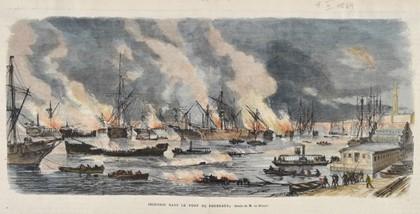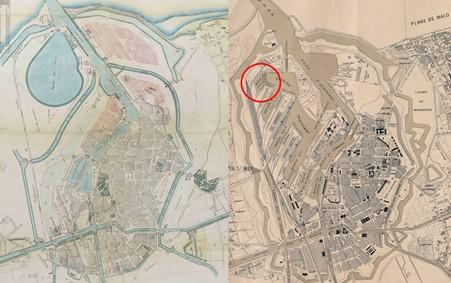Stephan Hauser

The explosion in the port of Beirut in 2020 showed that ports are clusters of risks, and that accidents in port areas can have disastrous effects on close-by residential areas or historic city centers. Such disasters are not new, and cities and nations have had time to establish special safety regulations and prevent such disasters. Because authorities implemented these rules in reaction to incidents rather than planning to prevent and enforcing existing rules, however, more disasters ensued. The evolution of industrial techniques and scales often overran the ability of law-makers to adapt rules and anticipate to industrial innovations.
Repeated incidents in oil ports sadly illustrate this. Disasters were especially rampant in the early years of the oil industry. Petroleum-related fires destroyed parts of the ports of Jersey and Antwerp in 1866. In 1867 and 1869, fires involving oil burnt 17 ships in the harbor of Bordeaux, due to negligence during the transshipment of oil (Figure 1). In 1891, a fire and explosion of the refinery Clère-Boilet in Dunkirk destroyed the site, leaking burning oil which spread out over 500 meters, killing seven persons and destroying numerous houses located around the facility (Denise, 1988).
These disasters did not come unannounced. Before the fire of the refinery, inhabitants of the city regularly alerted local authorities on the danger of this site and its possible impact on surrounding areas after multiple other fires had broken out in this same refinery. The facility was, however, rebuilt on the exact same place after the incident before closing in 1906. This sequence of disasters and rebuilding without improvement, demonstrates negligence and a lack of efficient enforcement of existing legal tools by public authorities.
In reaction to these repeated incidents, public authorities tried to tackle the environmental and health challenges emanating from ports. They could build upon earlier regulation like in 1810, when the French government had produced an imperial decree dealing with unhealthy and uncomfortable odors and smokes. Though never really applied, it already introduced innovations with a distance between industries and dwellings through a classification based on the inconvenience of their fumes. At the end of the 19th and beginning of the 20th century, with the development of the oil industry, the government issued other imperial decrees in 1866, 1872, 1879 and 1911 around the transformation, transportation, and storage of flammable substances (Sillans, 2000). The regular creation of legal texts and the continuous incidents linked to petroleum activities demonstrate that the issue behind security does not rely on the creation of tools alone, but also on the efficient implementation of the rules.
One example is the case of Dunkirk. Its modern shape was notably influenced by the “plan Freycinet” (named after the public works minister Charles Freycinet) from 1878 which aimed to improve port infrastructure and stimulate industrial activities. The plan proposed the upgrading of French port facilities with new railways and canal connections, and the removal of petroleum transshipment areas from the city centre to a dedicated basin, equipped with a floating dam (Figure 2). In Dunkirk, the enforcement of regulations did not lead to the division between industrial and urban areas. Instead, it resulted from new economic strategies aiming to improve the efficiency and attractiveness of French port cities for industries.

Over more than 150 years, governments in all countries around the globe have made laws about environmental risk and refined them with each new disaster. The chemical pollution of Seveso, in Italy in 1976, led to a European regulation of the same name (in 1982) to define planning measures around dangerous sites in Europe. It prevents for instance the construction of houses in a perimeter around certain industrial facilities, which are now called Seveso sites. The explosion of a fertilizer plant in Toulouse, France, in 2001, led to further improvements in the French system with “technological risk prevention plans” around dangerous sites with more restrictions and conditions for surrounding urban areas.
With the prevalence of these Seveso sites (Dunkirk alone counts 14 of these sites in its port area) the enforcement of security rules around industrial facilities is crucial. Since the beginning of the 20th century, moreover, the threat has only grown with industrial facilities growing bigger. Public authorities, though creating new spatial planning and security rules, are still struggling to enforce and monitor their application around industrial sites of port cities. The real estate pressure in port cities pushes urban areas closer to the port. This urban expansion linked to a demographic growth progressively led cities to engulf industrial sites, formerly at their periphery, into their urban tissue, increasing risks and potential damages in case of incident (Dechy, 2004).
The European Parliament has regularly pointed out shortages of qualified inspectors and safety around classified industrial sites in Europe (European Parliament, 2001). Such reports reveal a global lack of control on private companies' compliance with security rules. Industrial and urban areas can often have, beyond the only case of port cities, a tight and dangerous relationship. Where space is still available, dangerous industries are pushed away from urban areas. But when space is scarce, other solutions exist like imposing more resilient and adapted construction techniques for houses, or stricter security measures for industrial facilities.
One of the issues around the creation and improvement of security measures is that they are lagging several steps behind the ever developing and growing industrial complexes. Despite the development of supra-national objectives and rules (especially within the EU), their inclusion into national systems comes with interpretations and grey zones. Industrial actors sometimes use this lack of clarity to their benefit (Cash Investigation, 2016). Furthermore, there is a lack of independency and means for services in charge of monitoring the enforcement of national or supra-national rules. Recent new bodies, independently dealing with Development and Supervision within French port authorities, illustrate that public authorities increasingly acknowledge the importance of separating strategic thinking from monitoring in order to make port cities safer (Hauser, 2019). Thus, since the 1860s, the biggest challenge in improving the security in port cities is not the availability of legal tools and texts, but rather their monitoring and enforcement.
Acknowledgement
This blog has been written in the context of discussions in the LDE PortCityFutures team. It reflects the evolving thoughts among group members on the socio-spatial and cultural questions surrounding port city relationships. Special thanks for comments and reviews to Maurice Jansen and Didem Yerli.
References
J. Denise. La Belle Époque à Dunkerque. Vol. 3. 1988.
C. Sillans. "Au service du Diable": pour une histoire de la gestion des risques: incendies et organisations de secours: Lyon, 1852-1913. Diss. Lyon 2, 2000: 121-126.
N. Dechy, T. Bourdeaux, N. Ayrault, M.-A. Kordek, and J.-C. L. Coze. “First lessons of the Toulouse ammonium nitrate disaster, 21st September 2001, AZF plant, France”. Journal of Hazardous Materials 111.1-3 (2004): 131–138.
European Parliament. European Parliament resolution on the explosion at a factory in Toulouse (France). 2001. https://op.europa.eu/en/publication-detail/-/publication/d22e3365-3369-4fb6-ab80-6922f4f59278
Cash Investigation. Climat : le grand bluff des multinationales. 2016. https://www.francetvinfo.fr/replay-magazine/france-2/cash-investigation/cash-investigation-du-mardi-24-mai-2016_1454987.html
S. J. Hauser. “The Interplay of Economic Development and Environmental Protection: Dunkirk and the Search for Balance”. PORTUSplus (2019): 8.
Banner image : "Gibraltar Explosion" by Josh13770 is licensed under CC BY 2.0.
